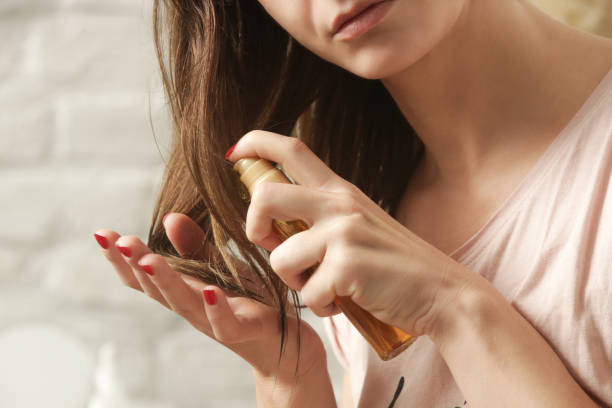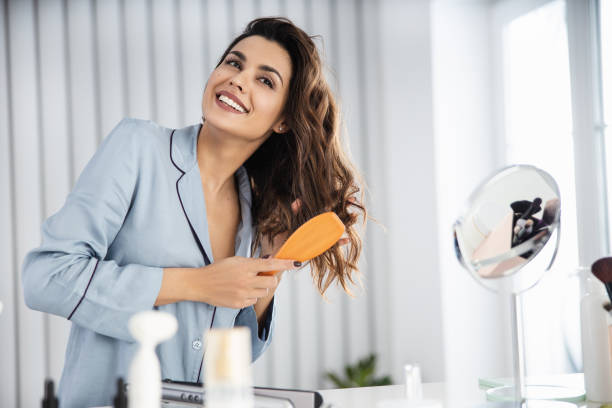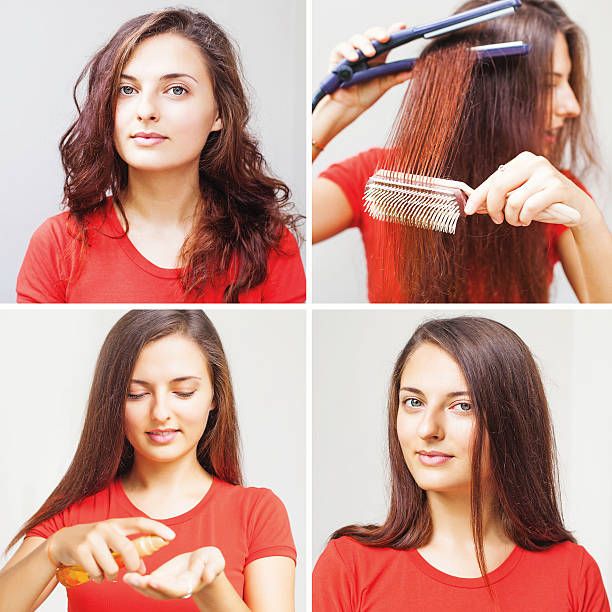Introduction
Welcome to the world of hair care, a realm where the proper knowledge and practices can transform your hair from ordinary to extraordinary. Hair is not just a part of our appearance; it’s a reflection of our identity and health. It’s a canvas that allows us to express ourselves, and like any valuable asset, it requires proper care and attention. This guide will help you understand and care for your hair. We will cover hair types, essential care, and advanced techniques for healthy hair.
I. Understanding Your Hair Type

Identifying Your Hair Type
Straight, Wavy, Curly, Coily
There are different types of hair, each with their own unique characteristics. Straight hair is usually smooth and sleek, and can range from fine to thick and coarse. Wavy hair is a hair type that falls somewhere in between straight and curly. often with a gentle, tousled look. Curly hair is known for its distinct spirals and can vary from loose, bouncy curls to tight ringlets. The most voluminous type is coily hair, which features tight rings or zigzags all the way from the scalp.
Tips for Determining Your Hair Type
To identify your hair type:
- Observe your hair’s natural state after washing and air-drying.
- Avoid styling products during this test, as they can alter your hair’s actual texture.
- Consider the shape of your curls or the lack thereof, and note the thickness and overall behavior of your hair.
The Science Behind Hair Types
Hair Porosity and Scalp Types
Understanding hair porosity – your hair’s ability to absorb and retain moisture – is crucial. High-porosity hair absorbs moisture quickly but loses it just as fast, while low-porosity hair resists moisture absorption. Scalp type, ranging from dry to oily, also plays a significant role in hair health.
Genetics and Environment
Your hair’s characteristics are heavily influenced by genetics, dictating its color, texture, and growth patterns. Environmental factors like climate, pollution, and water quality can affect your hair’s condition and appearance.
II. Essentials of Hair Care

Shampooing Basics
Selecting the Right Shampoo
The choice of shampoo impacts your hair’s health significantly. Opt for a shampoo that aligns with your hair type and scalp condition. For instance, hydrating shampoos suit dry hair, while balancing shampoos are ideal for oily scalps.
Washing Frequency
Hair washing frequency depends on hair type. Oily hair requires more washing, while dry or curly hair benefits from less shampooing to keep natural oils.
The Role of Conditioners
How Conditioners Work
Conditioners are vital for restoring moisture, detangling, and smoothing the hair cuticle. They also help reduce frizz and add shine.
Conditioning Tips
Deep condition once a week to improve hair health. Focus on mid-lengths and ends to avoid oily scalp.
Hair Masks and Treatments
Benefits and Timing
Hair masks are intensive treatments that address specific hair concerns, such as dryness or damage. Depending on your hair’s needs, use them periodically to infuse nutrients and restore vitality.
DIY Treatments
Natural, homemade treatments can be effective and budget-friendly. Ingredients like coconut oil, avocado, honey, and yogurt offer nourishing benefits and are easily accessible.
III. Advanced Hair Care Techniques

Hair Oiling Rituals
Benefits of Hair Oiling
Oiling nourishes the scalp strengthens hair roots, and promotes growth. It also adds luster and can help combat dryness and dandruff.
Choosing and Applying Oils
Select oils according to your hair type—coconut oil for most hair types, argan oil for dry and curly hair, and jojoba oil for oily hair. Massage warm oil into the scalp, leave overnight, and wash out.
Managing Hair Problems
Common Issues
Dandruff, hair fall, and split ends are prevalent concerns. Regular maintenance, including proper cleansing, conditioning, and trimming, can help manage these issues.
Professional vs. Home Remedies
While home remedies can be effective for mild issues, more severe problems may require professional treatment. Understand when to seek help from a hair care specialist.
Hair Styling Without Damage
Safe Styling Tips
Avoid heat styling as much as possible to prevent damage. When using heat tools, apply a heat protectant and use the lowest effective temperature.
Choosing Styling Tools
Invest in quality styling tools with adjustable heat settings. Ceramic and tourmaline tools are generally safer and more hair-friendly.
IV. Lifestyle and Hair Health

Diet for Healthy Hair
Essential Nutrients for Hair Health
A balanced diet plays a pivotal role in maintaining healthy hair. Key nutrients include:
- Protein: Hair is made of protein, so a diet rich in lean meats, fish, beans, and legumes is essential for hair growth and strength.
- Iron: Iron deficiency is a significant cause of hair loss, particularly in women. Rich sources of iron include red meat, spinach, and lentils.
- Vitamins A and C: These vitamins aid in sebum production and collagen synthesis, respectively. Carrots, sweet potatoes, and citrus fruits are excellent choices.
- Omega-3 Fatty Acids: They provide the oils that keep your scalp and hair hydrated. Salmon, avocado, and nuts are excellent sources.
Foods to Include in Your Diet
It is essential to include a diverse range of fruits, vegetables, whole grains, and lean proteins in your diet. Make sure to incorporate all these food groups for a balanced and healthy diet. Foods like berries, nuts, and green leafy vegetables are not only nutritious but also beneficial for hair health.
The Impact of Lifestyle on Hair
Stress, Sleep, and Exercise
- Stress: Stress can cause hair loss. Doing yoga and meditation can help.
- Sleep: Getting enough quality sleep is crucial for overall health and hair growth, as during sleep, the body repairs and regenerates hair follicles.
- Exercise: Regular exercise boosts overall health and improves blood circulation, which can stimulate hair growth.
Tips for a Hair-Friendly Lifestyle
Adopting a healthy lifestyle can improve the health of your hair. It is essential to stay hydrated, avoid smoking, and limit alcohol consumption. Remember, a healthy body promotes healthy hair.
V. Special Hair Care Needs

Hair Care for Different Ages
Adapting Your Routine Over Time
As you age, your hair changes. It is important to modify your hair care routine in accordance with these changes:
- In Your 20s and 30s: Focus on prevention. Use protective styles, avoid excessive heat styling, and incorporate regular trims.
- In Your 40s and Beyond: Hair may begin to thin and lose its luster. Opt for volumizing products and consider lighter hair colors to camouflage thinning.
Seasonal Hair Care
Adjustments for Different Seasons
- Summer: Protect your hair from sun damage with hats and UV-protective sprays. Increase hydration with masks and leave-in conditioners.
- Winter: Combat dryness caused by cold air and indoor heating with richer moisturizers and fewer washes.
Hair Care for Chemically Treated Hair
Special Considerations for Colored or Permed Hair
Chemically treated hair requires extra care:
- Moisturize Regularly: Coloring and perming can leave hair dry and brittle. Deep conditioning treatments are vital.
- Avoid Sulfates: Use sulfate-free shampoos to prevent stripping away hair color and moisture.
- Trim Frequently: To avoid split ends, regular trims are essential.
VI. Emerging Trends and Innovations in Hair Care

Latest Trends in Hair Care
New Products and Methods
The hair care industry is constantly evolving, introducing innovative products and methods:
- Customizable Hair Care: Personalized shampoos and conditioners, formulated based on individual hair assessments, are gaining popularity.
- Scalp Health Focus: Products targeting scalp health, like scalp scrubs and serums, are on the rise, recognizing the scalp’s role in overall hair health.
- Heat-Free Styling: Tools and products for heat-free styling are trending, emphasizing hair health without compromising on style.
Sustainable and Organic Hair Care
Eco-Friendly and Organic Options
Sustainability is a growing focus in hair care:
- Eco-Friendly Packaging: Brands are shifting towards recyclable and biodegradable packaging to reduce environmental impact.
- Natural Ingredients: There’s an increasing demand for products with organic, plant-based ingredients, free from harsh chemicals.
- Waterless Hair Products: Waterless shampoos and conditioners are emerging, offering an eco-friendly option that conserves water.
The Future of Hair Care
Predictions and Upcoming Technologies
The future of hair care looks promising with technological advancements:
- Bright Hair Brushes: Brushes that can analyze hair health and provide feedback are being developed.
- Advanced Hair Regrowth Treatments: Innovations in hair regrowth, including stem cell research and laser therapy, show potential for treating hair loss.
- Virtual Hair Consultations: Online platforms offering personalized hair care advice are becoming more prevalent.
A New Perspective on Hair Care

In wrapping up, it’s clear that hair care is more than just a routine; it’s a journey of understanding and nurturing your unique hair. We’ve covered the essentials of hair care, from recognizing your hair type to adopting a hair-friendly lifestyle, and explored the exciting world of emerging trends and innovations.
Embrace your unique hair type and treat it with the care it deserves. Healthy hair reflects overall health and lifestyle choices. Be mindful to maintain natural beauty.
References and Resources
For further reading and exploration, consider the following:
- Books: “The Science of Black Hair” by Audrey Davis-Sivasothy, “Curly Girl: The Handbook” by Lorraine Massey.
- Websites: NaturallyCurly.com , TheLonghairs.us
- Products: Look for brands with a strong focus on sustainability and personalized hair care.
Frequently Asked Questions (FAQ)
1- How often should I wash my hair?
Answer: It depends on your hair type. Oily hair may require more frequent washing, while dry or curly hair benefits from less frequent washing.
2- Can diet really affect my hair health?
Answer: A balanced diet rich in proteins, vitamins, and minerals is crucial for healthy hair.
3- What’s the best way to protect my hair from heat damage?
Answer: Use a heat protectant spray and choose heat styling tools with adjustable temperature settings.
4- Are sulfate-free shampoos better?
Answer: Yes, especially for dry, curly, or chemically treated hair, as sulfates can strip natural oils.
5- How can I deal with hair fall?
Answer: Maintain a healthy diet, reduce stress, and avoid harsh hair treatments. If the problem persists, consult a specialist.
6- What are some natural hair mask ingredients I can use?
Answer: Avocado, honey, coconut oil, and yogurt are great for DIY hair masks.
7- How can I identify my hair type?
Answer: Observe your hair’s natural texture and how it behaves when dry. Consider factors like curl pattern, strand thickness, and scalp condition.
8- What are some excellent hair care tips for aging hair?
Answer: Use volumizing products, minimize heat styling, and consider lighter hair colors to camouflage thinning.
9- How do I know if a hair care product is truly organic?
Answer: Check for certifications like USDA Organic or ECOCERT, and read the ingredients list for natural components.
10- Are there any benefits to using hair oil?
Answer: Yes, hair oils can nourish the scalp, strengthen hair, promote growth, and add shine.
Read also.. Food for Hair Growth : A Comprehensive Guide to Food for Hair Growth

